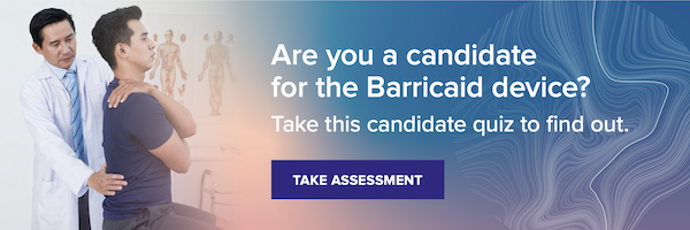 Research shows1 that one-third of people aged 40-59 years old have image-based evidence of moderate to severe degenerative disc disease (DDD), and the prevalence increases 2-4 fold in those aged 60 and older. In fact, in the U.S. alone, nearly 5.7 million people2 are diagnosed with intervertebral disc disorders like DDD each year.
Research shows1 that one-third of people aged 40-59 years old have image-based evidence of moderate to severe degenerative disc disease (DDD), and the prevalence increases 2-4 fold in those aged 60 and older. In fact, in the U.S. alone, nearly 5.7 million people2 are diagnosed with intervertebral disc disorders like DDD each year.
In this article, we’ll tell you all about degenerative disc disease: what it is, known causes and lifestyle risks, symptoms to look for, and what you can do to prevent it—or at least live with it more comfortably.
What Is Degenerative Disc Disease?
Degenerative disc disease is not really a specific disease, but a vague term used to describe the progressive (and expected) changes our spinal discs encounter throughout the aging process. It may encompass a number of different symptoms and conditions.
Common Symptoms
DDD is the most common cause of lower back pain that may radiate down the leg and into the foot and ankle. However, it’s important to note that not all cases of DDD are painful—it all depends on the individual, their lifestyle, and the severity of their degeneration. Symptoms tend to crop up due to spinal instability, nerve root compression, and/or muscle tension in the lumbar spine.
The most common symptoms of DDD include:
- Pain primarily in the lower back and legs
- Pain that seems to worsen while sitting down
- Pain that comes and goes over periods of time
- Tingling and numbness radiating down legs
- Pain that radiates to the buttocks or thighs
- Foot drop (difficulty lifting the front of your foot)
- Pain that worsens after twisting or bending
- Weakened muscles and decreased mobility
It’s important to note that painful symptoms of DDD can worsen over time and cause mild to extreme pain, depending on your everyday activities and lifestyle risks. That’s why if you’re experiencing any of the symptoms we’ve outlined above—especially if they tend to come and go—it’s imperative you see a doctor sooner rather than later to determine the cause of your pain and identify potential causes and treatments for relief.
Causes and Risk Factors
Wondering what causes DDD? Age-related wear and tear on our spinal discs is actually the biggest risk factor. Our lumbar discs act as soft cushions between the bones, or vertebrae, that make up the spine, and bear the weight of each of our daily activities. Over time, those discs naturally begin to dehydrate, stiffen, and shrink.
As our spinal discs lose water, they also lose their flexibility, elasticity, and shock-absorbing capacity, all of which can contribute to painful symptoms, further degeneration, and the onslaught of other related conditions such as lumbar disc herniation. According to a systematic review of spine imaging findings3, the prevalence of disc degeneration in asymptomatic individuals rose from 37 percent of 20-year-olds, to 96 percent of 80-year-olds. These findings make clear that spine degeneration increases drastically due to normal aging, though is often unassociated with pain.
With that being said, obesity, a sedentary lifestyle, and traumatic accidents and injuries (e.g., a car accident or sports injury) can all increase your risk of developing DDD or symptoms increasing in terms of severity, though studies reveal that there’s a strong correlation4 between obesity, diabetes, and tobacco dependency and the likelihood of developing degenerative disc disease.
Medical Diagnosis
Medical practitioners disagree when it comes to what is and is not considered DDD. According to Spine-Health5, “There is little consensus in the medical literature regarding what does and does not constitute a diagnosis of degenerative disc disease.”
With so many discrepancies, accurately diagnosing and treating spinal conditions can be particularly challenging. Spine specialists typically perform a physical exam, inquire about symptoms, and order imaging tests such as magnetic resonance imaging (MRI) scans, computed tomography (CT) scans, or x-rays.
Imaging tests allow physicians to get a closer look at the lumbar discs and surrounding structures, helping to reveal any damaged discs and rule out other potential causes of the pain you’re experiencing. For example, degenerative disc disease is the most common cause of both bulging and herniated discs in the lumbar spine.
Preventing and Treating Degenerative Disc Disease
Although some degree of disc degeneration is normal and difficult to prevent entirely, knowing the lifestyle risks and taking steps to reduce your likelihood of developing DDD can go a long way in improving your condition and minimizing damage to your discs. Lifestyle changes can have a significant impact on your spine health and any pain you may be experiencing in your lower back or legs.
For example, eating a nutritious diet, maintaining a healthy weight and posture, quitting smoking and the use of other tobacco products, increasing your daily activity levels, engaging in low-impact exercises, strengthening your core, and reducing spinal loads (e.g., taking breaks during long car rides and minimizing heavy lifting) can all aid in preventing and treating DDD.
In cases where symptomatic DDD isn’t preventable, there are several nonsurgical treatments available to decrease the frequency and intensity of associated lower back and leg pain. The most effective nonsurgical treatments include the following.
Pain Management
Both over-the-counter (OTC) and prescription pain medications can relieve painful symptoms due to disc degeneration. Nonsteroidal anti-inflammatory drugs (NSAIDs) like ibuprofen, aspirin, and naproxen can reduce inflammation contributing to stiffness, discomfort, and nerve root irritation.
Prescription painkillers such as muscle relaxants and narcotics are also effective during instances when severe pain that is not relieved using OTC medications. Steroid injections can also be injected locally in the area where you’re experiencing pain to reduce inflammation and alleviate any discomfort.
Physical Therapy
Many patients with degenerative disc disease experience relief from pain and improved mobility as a result of physical therapy. A physical therapist can work with you to stretch tight muscles, strengthen your lower back and core muscles, and get you up and moving. Another great benefit to physical therapy is that it can be custom-tailored to your exact specifications, or your overall health, preferences, and severity of symptoms.
Exercise and Stretching
Regular exercise and stretching can make a huge difference when it comes to the frequency and severity of your pain, and any subsequent weight loss is an added benefit, because being overweight puts added stress on your spine. Certain yoga poses and other low-impact activities like walking, cycling, and swimming can all help to stretch out tense lower back and core muscles, relieving pain and improving mobility.
Heat and Cold Therapy
Hot and cold packs are very effective at helping manage painful symptoms caused by stiff muscles and inflammation. Applying heat improves circulation, ultimately reducing muscle spasms and tension to improve your mobility. On the other hand, ice packs can reduce inflammation and have a numbing effect to decrease mild pain.
Less commonly, some patients whose disc degeneration leads to lumbar disc herniation may require discectomy surgery to help them stay active and pain-free. A spine specialist can make an accurate diagnosis and recommend the best treatment for you.
Keeping Your Spine as Healthy as Possible
Some level of disc degeneration is natural and to be expected as we age. However, by learning what degenerative disc disease is, taking the proper precautions, and being aware of lifestyle risk factors, you can minimize disc degeneration, reduce intermittent pain, and keep your spine as healthy as possible for as long as possible.
While this blog is meant to provide you with the information you need to make an informed decision about your treatment options, it is not intended to replace professional medical care or provide medical advice. If you have any questions about the Barricaid, please call or see your doctor, who is the only one qualified to diagnose and treat your spinal condition. As with any surgical procedure, you should select a doctor who is experienced in performing the specific surgery that you are considering.
If you have any questions about the Barricaid, you may ask your doctor. For additional information, please visit www.barricaid.com. For complete risk-benefit information: www.barricaid.com/instructions-for-use.
References
1. Hebrew SeniorLife Institute for Aging Research, "One third of people aged 40-59 have evidence of degenerative disc disease," ScienceDaily (2018):
2 Theodore Steelman, "Population-Based Risk Factors for the Development of Degenerative Disc Disease," The Spine Journal 16, no. 10 (2016): 342-343, doi:10.1016/j.spinee.2016.07.272
3 W Brinjikji et al, "Systematic literature review of imaging features of spinal degeneration in asymptomatic populations," AJNR Am J Neuroradiology 36, no. 4 (2015): 342-343, doi:10.3174/ajnr.A4173.
4 Theodore Steelman et al, "Population-based Risk Factors for the Development of Degenerative Disk Disease," Clinical Spine Surgery 31, no. 8 (2018): doi:10.1097/BSD.0000000000000682.
5 Brian McHugh, “What Is Degenerative Disc Disease?” Veritas Health, 2017, https://www.spine-health.com/conditions/degenerative-disc-disease/what-degenerative-disc-disease.



Comments